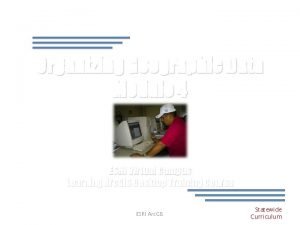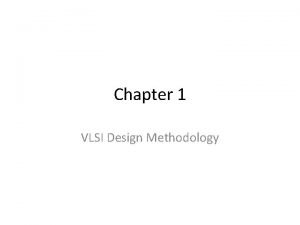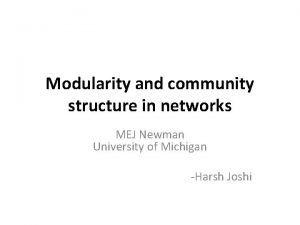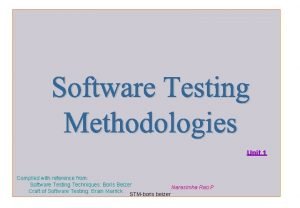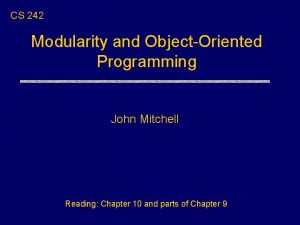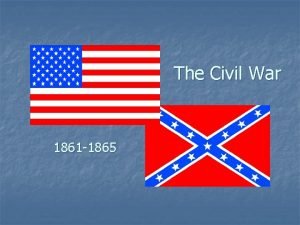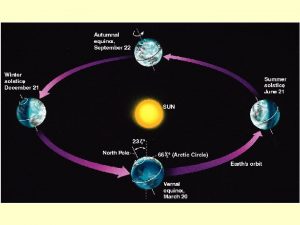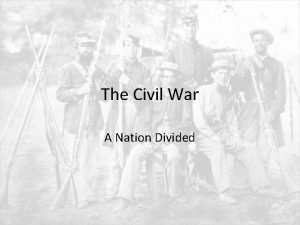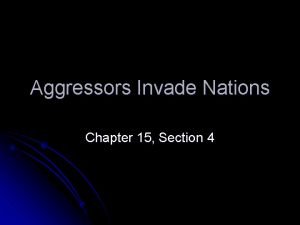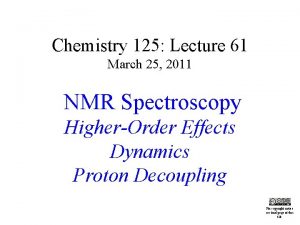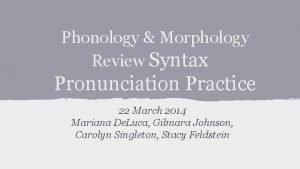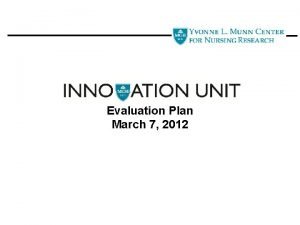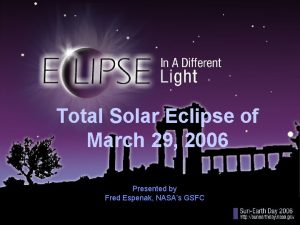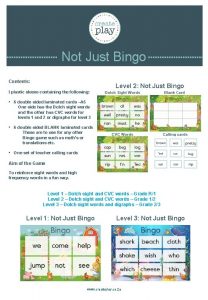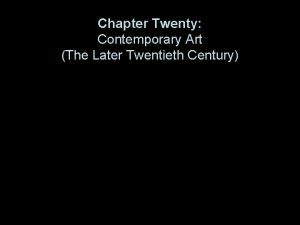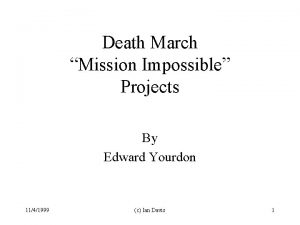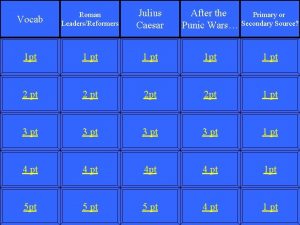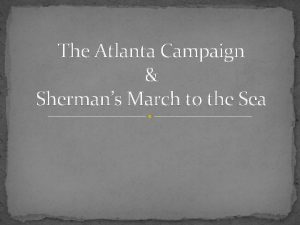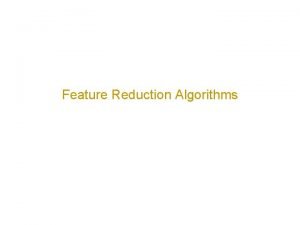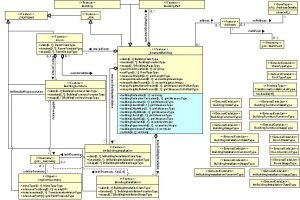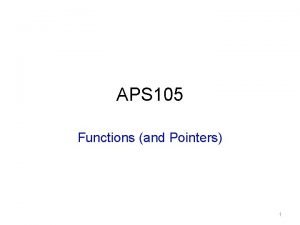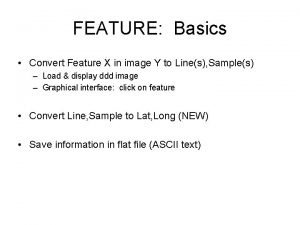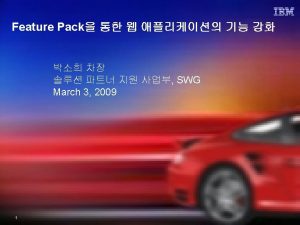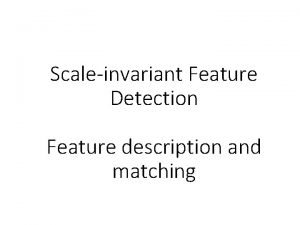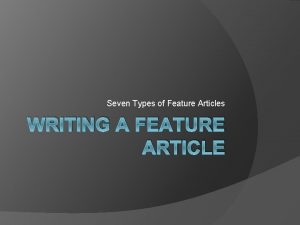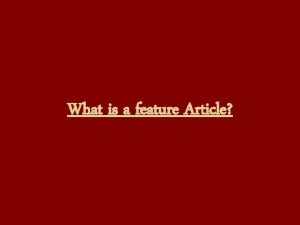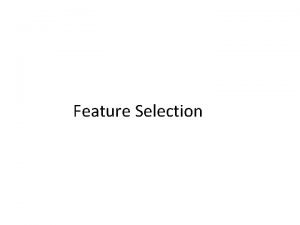Feature Modularity Jo Atlee Modularity March 2015 David


![what is a feature? “unit of functionality” [Hall, 2000] - additive / incremental - what is a feature? “unit of functionality” [Hall, 2000] - additive / incremental -](https://slidetodoc.com/presentation_image/0b6daf5f0419f2239bb2ae28c9433c11/image-3.jpg)













![introduced in several phases Bowen, SETSS’ 89 [req] understanding / specifying how features ought introduced in several phases Bowen, SETSS’ 89 [req] understanding / specifying how features ought](https://slidetodoc.com/presentation_image/0b6daf5f0419f2239bb2ae28c9433c11/image-17.jpg)
![feature interaction problem death by exceptions [Zave] F 1 = f 1 + e feature interaction problem death by exceptions [Zave] F 1 = f 1 + e](https://slidetodoc.com/presentation_image/0b6daf5f0419f2239bb2ae28c9433c11/image-18.jpg)


















![serializing features Distributed Feature Composition [Jackson, Zave, TSE’ 98] pipeline architecture + + - serializing features Distributed Feature Composition [Jackson, Zave, TSE’ 98] pipeline architecture + + -](https://slidetodoc.com/presentation_image/0b6daf5f0419f2239bb2ae28c9433c11/image-37.jpg)



- Slides: 40

Feature Modularity Jo Atlee • Modularity • March 2015 David R. Cheriton School of Computer Science University of Waterloo

feature-oriented software development Cruise Control Stability Control Anti-Theft stakeholders’ mental model of system Cruise Control Stability Control Anti. Theft Cruise Control feature-oriented software system
![what is a feature unit of functionality Hall 2000 additive incremental what is a feature? “unit of functionality” [Hall, 2000] - additive / incremental -](https://slidetodoc.com/presentation_image/0b6daf5f0419f2239bb2ae28c9433c11/image-3.jpg)
what is a feature? “unit of functionality” [Hall, 2000] - additive / incremental - optional “a modification of or an addition to a service, and does not stand on its own” [Bellcore 1992] “a tariffable unit” [Bellcore 1992] “a unit of variability” “a requirement” [Zave 2015] “a characteristic / property / quality / aspect / profile / concern of the system”

feature-oriented software development feature : a requirement Cruise Control Stability Control Anti-Theft stakeholders’ mental model of system Cruise Control Stability Control Anti. Theft Cruise Control feature-oriented software system

feature interactions feature interaction: a feature behaves differently in the presence of another feature than it behaves in isolation › › nondeterministic conflicting actions violate global correctness property emergent behaviours

hybrid brakes �anti-lock breaking 2010 Toyota Prius hybrid brake system › › (normal) hydraulic brake system regenerative braking system - converts loss of vehicle momentum into electrical energy stored in on-board batteries anti-lock brake system (ABS) › maintains stability, steerability during panic braking interaction › › › braking force after ABS actuation reduced vehicle stopping distance is increased 62 reported crashes, 12 injuries

cruise control �traction control cruise control › vehicle set to maintain driver-specified speed traction control › brake fluid applied when wheels slip interaction › › engine power is increased (to maintain speed) driver senses “sudden acceleration” - vehicle becomes difficult to control resolution › advise drivers not to use cruise control on slippery roads

not all interactions are bad! intended interactions › › › advanced cruise-control variants override basic cruise control prohibit navigation overrides navigation prohibit-navigation overrides prohibit-navigation unintended but harmless interactions › call screening prevents activation of caller id (planned) resolutions to conflicts › brake overrides (acceleration �braking)

all interactions require work • verify intended interactions • detect unexpected interactions • analyze them for undesired interactions • fix undesired interactions - faulty feature disallow feature combination resolve interaction using exceptions / new features • test the fixes

feature modularity vs. interactions FOSD emphasizes features de-emphasizes interactions but still must detect, analyze, fix, test interactions this is exactly the chore that feature-orientation was meant to avoid!

what this talk is about history of feature modularity › › representing features as isolated modules (some) information hiding addressing feature interactions › › scalable to large numbers of features supports third-party development

approach #1: feature module = co-location of feature’s code

interactions resolved using exceptions F 1 = f 1 + e f 2 + e f 3 + … + ef n + e f 2 f 3 + e f 3 f 4 + … + ef 2 f 3…fn

lots of features e. g. , telephony has 1000+ features per system device’s features provider’s features PBX features provider’s features a system of feature-rich systems › features from multiple providers › multiple active versions of the same feature device’s features

lots of interactions results of the second feature interaction contest

lots of types of interactions control-flow one feature affects the flow of control in another feature data-flow one feature affects (deletes, alters) a message destined for another feature data modification shared data read by one feature is modified by another feature data conflict two features modify the same data control conflicts two features issue conflicting actions assertion violation one feature violates another feature's assertions or invariants resource contention the supply of resources is inadequate, given the set of competing features
![introduced in several phases Bowen SETSS 89 req understanding specifying how features ought introduced in several phases Bowen, SETSS’ 89 [req] understanding / specifying how features ought](https://slidetodoc.com/presentation_image/0b6daf5f0419f2239bb2ae28c9433c11/image-17.jpg)
introduced in several phases Bowen, SETSS’ 89 [req] understanding / specifying how features ought to interact [req] the number of interactions (and resolutions) to consider grows exponentially with the number of features [design] more interactions introduced during design due to sharing of resources, I/O devices, protocol signals, etc. [imp] near-commonalities among features leads to questions about how to effectively reuse software components [test] the sheer number of interactions and resolutions to be tested lengthens the testing phase
![feature interaction problem death by exceptions Zave F 1 f 1 e feature interaction problem death by exceptions [Zave] F 1 = f 1 + e](https://slidetodoc.com/presentation_image/0b6daf5f0419f2239bb2ae28c9433c11/image-18.jpg)
feature interaction problem death by exceptions [Zave] F 1 = f 1 + e f 2 + e f 3 + e f 4 + ef 5 + ef 6 + ef 7 + ef 8 + ef 9 + ef 10 + ef 11 + ef 12 + ef 13 + ef 14 + ef 15 + ef 16 +…+ efn interactions • dominate feature development • complicate third-party feature development

approach #2: feature module = black box

feature modules features are independent entities that are oblivious to the presence of other features - each module’s interface is simply its inputs and outputs to a shared environment inputs outputs • enables third-party feature development • simplifies detection of interactions

detecting feature interactions feature F 1 1 2 F 2 ⊨Φ ⊨Φ requirements of feature (property) Fn F 1 �F 2 � �Fn feature composition ⊨Φ ⊭Φ n 1 ∧ Φ 2 ∧ ∧ Φn

call forward vs. voice mail CFNA call is forwarded to new directory number VM message is from the caller is recorded CFNA + VM ? forward call ∧ record message

nonmonotonic resolutions (Veldhuijsen’ 95) adding a new feature can change the requirements of existing features: • nonmonotonic extensions – e. g. , Freephone changes billed party • changes to definitions of terms – e. g. , refinement of the notion of being busy – e. g. , evolution of a call – e. g. , evolution of directory numbers; of private numbers • violation of invariants / assumptions – “I have not been able to think of a single interesting assertion that would be true of a system incorporating all [features of the public switched telephone network]. ” [Zave’ 01]

feature interaction problem death by “interaction features” F 1 + F 2 + F 3 + … + F n + F 1#F 2 + F 1#F 3 + … Fn-1#Fn + F 1#F 2#F 3 + F 1#F 2#F 4 + + F 1#F 2#F 3#. . . #Fn aiming for perfect resolution of interactions doesn’t scale

best resolution not always obvious VM X CF VM Y’s features Z’s features X calls Y, which forwards the call to Z, and the call attempt fails. whose VM should react? • what if Y is a sales group and Z is a sales representative? • what if Y is on a long leave of absence?

approach #3: feature modules with interfaces

interfaces and information hiding interface advertises what services a module provides to the rest of the system, and how they can be accessed information hiding encapsulates a design decision inside a module, whose interface reveals only externally visible properties [Parnas’ 72]

interfaces feature interface defines what services a feature provides to the rest of the system and how other features can access those services family interface public interface inputs / outputs less expressive accessors mutators extension points more expressive

feature families Cruise. Control Speed. Limit. CC + CC#SLCC Curve. CC + CC#CCC + SLCC#CCC + CC#SLCC#CCC Headway. Control + CC#HC + SLCC#HC + CCC#HC… Climate Control Anti-theft Lighting Power Windows

minimal public interface most inter-feature references are to high-level common modes of operation examples Feature. X_Fail flag is set to true when Feature. Y is in fail state Feature. Q is enabled only if Feature. P is enabled

minimal public interface most inter-feature references are to high-level common modes of operation Failed Inactive public interface private Active Monitoring Controlling Monitoring

generic public interface modes of operation can serve as criterion for structuring feature modules

generic public interface (2)

2 strategies for resolving interactions feature families resolve interactions within a feature family perfectly (e. g. , new “interaction” features) unrelated features handle unexpected interactions between unrelated features using default resolution strategies

resolving interactions between unrelated features

feature coordination given a collection of feature families, each with a minimal public interface… … want to coordinate the features’ executions such that entire classes of interactions are resolved by default inputs outputs
![serializing features Distributed Feature Composition Jackson Zave TSE 98 pipeline architecture serializing features Distributed Feature Composition [Jackson, Zave, TSE’ 98] pipeline architecture + + -](https://slidetodoc.com/presentation_image/0b6daf5f0419f2239bb2ae28c9433c11/image-37.jpg)
serializing features Distributed Feature Composition [Jackson, Zave, TSE’ 98] pipeline architecture + + - features make no assumptions about other features avoids simultaneous reactions to the same event conflicts are resolved through serialization feature ordering realizes a priority scheme resolution is implicit

parallel execution (resolution modules) Resolver o 1 output Resolver o 2 output Resolver o 3 output inputs + features make no assumptions about other features + conflicting actions are resolved by resolution modules + all actions are considered in resolution + resolution strategies can be variable-specific

feature coordination › fixed set of features › pre-determined › fixed set of features › semi-configurable selection of features › static integration › perfect coordination possible › set of static integrations › perfect coordination possible, but impractical › unlimited features › user-defined selection of features › dynamic integration › loose coordination

summary tight integration of feature families › no interfaces › perfect resolution + + = (looser) coordination of unrelated features › feature interfaces › default resolution › relax “correctness” [CC implies [CC] [HC] and [CC and [HC] [CC and Resolver O 1 [CC implies [CC] [HC] and [CC and [HC] [CC] … modular features [CC and Resolver On [CC implies [CC] [HC] and [CC] [CC and [CC] [HC]
 Jo atlee
Jo atlee March march dabrowski
March march dabrowski British cartoon by david low 1934
British cartoon by david low 1934 Isolated feature combined feature effects
Isolated feature combined feature effects Feature dataset vs feature class
Feature dataset vs feature class Y chart in vlsi design
Y chart in vlsi design Community detection in networks
Community detection in networks Dichotomies in software testing
Dichotomies in software testing Modularity oops
Modularity oops Joyful mysteries
Joyful mysteries Path of sherman's march to the sea
Path of sherman's march to the sea Current events quiz
Current events quiz March newsletter kindergarten
March newsletter kindergarten Ce abrasive blasting respirator
Ce abrasive blasting respirator 21 march equinox
21 march equinox Royal march banner
Royal march banner Sherman's march significance
Sherman's march significance 15.4 guided reading aggressors invade nations answers
15.4 guided reading aggressors invade nations answers March 25 2011
March 25 2011 Glasgow 5th march
Glasgow 5th march Salt march
Salt march January february march season
January february march season March verb
March verb March 27, 2013
March 27, 2013 Jan rose kasmir
Jan rose kasmir March 7, 2012
March 7, 2012 March 23 world meteorological day
March 23 world meteorological day Astronomy picture of the day march 29 2006
Astronomy picture of the day march 29 2006 Not just bingo
Not just bingo Performance art
Performance art Death march edward yourdon
Death march edward yourdon Source russia march
Source russia march March madness dataset
March madness dataset March 30 1981
March 30 1981 Ides of march punic wars
Ides of march punic wars March 14 445 bc
March 14 445 bc Path of sherman's march to the sea
Path of sherman's march to the sea The deguello is the traditional march of no
The deguello is the traditional march of no February march april may june
February march april may june March 1 1803
March 1 1803 The annunciation march 25
The annunciation march 25




